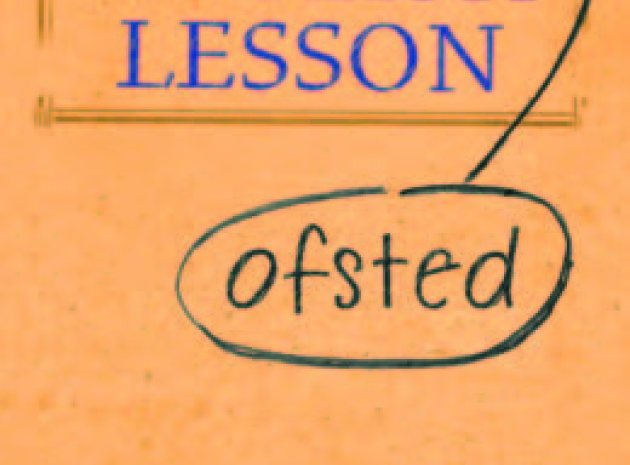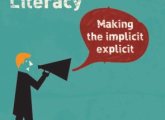The sad truth is that whilst observers see your planning, your interactions with a group of students and, hopefully, the evidence of impact in your students’ books, this is often just the tip of the iceberg. Most of what goes into making your lessons finely crafted things of beauty is invisible: it’s knowledge of your students and the relationships you’ve lovingly established over months or years; the routines you’ve set up and the massively high expectations you’ve communicated. Only we know how hard we’ve worked on these things – and if we hope that an observer can extrapolate it all from the 20 minutes they spend in our lesson, a brief conversation about targets, and a flick through a few books, then we could well leave ourselves open to disappointment. Instead we need to ensure that an observer knows all these things by taking the opportunity to point them out.
Now, I’ve always had high expectations of myself, and on those occasions where my lessons have been judged to be less than outstanding I’ve indulged in recrimination and self-doubt to the point of obsession. Being considered outstanding at what I do for a living is a matter of professional pride. It’s also a question of credibility; how can I expect to be taken seriously when observing others if I can’t cut the mustard myself? It’s all very well writing a book called The Perfect (Ofsted) English Lesson, but it does rather set you up for a fall.
So, to say there was some pressure to perform when my new head asked to observe my Year 11 class is something of an understatement.
We were studying Steinbeck’s classic, Of Mice and Men, and in the previous lesson we had started exploring characterisation. I put the class into home/expert groups and used Question Formulation Technique to get them to generate questions about the various characters in the novel. After going through the process they ended up with a short list of 3 ‘good’ questions, which we would revisit and refine next time.
So, when planning for the observed lesson I needed to demonstrate that students had made progress from that lesson to this.
Here’s the lesson I planned: I worked out that in order to get the individual writing done there wouldn’t be time for students to select their own quotations form the text so I stuck a selection of juicy quotes up around the room on what I call my ‘Stuck Stations’. These also contained a model response on Slim – a character they would not be writing about this lesson. In order to build a bit of anticipation I pumped out Joan Jett’s Bad Reputation as students came in and directed their attention to the question on the board: (Fig.2) As they were thinking, I nobbled a student, Arran, to let him know that he’d be leading the feedback on this task using the clarify, probe, recommend questions stems. This gave me time to take the register and chat about the context of the lesson to the head and the subject coordinator for English who were both observing. I always make it absolutely clear to any observer that they are witnessing outstanding teaching and learning and ensure they see those parts of the iceberg lying beneath the surface of the lesson. I point out why each individual is making ‘rapid and sustained progress over time’ and direct them to particular students and their books. The best lessons just seem to ‘flow’ with students experiencing an appropriate level of challenge and stress. However, this is hard to judge and we may need to ‘take the temperature’ of our lessons to ensure we’ve pitched it right. Get students to explain where they are on this chart:
You can then make micro adjustments to the levels of stress or challenge to make certain that students are displaying appropriate levels of ‘enthusiasm, participation & commitment’. After a brief discussion about the learning outcome and what would be expected, I asked students to select one question from their shortlist, which they felt would enable them to meet the outcome. We then used the Deeper Questioning Grid: (Fig.4) to refine the question so that it was suitably challenging. This was the part of the lesson I was most pleased with, and the students all wanted to push themselves to create the most challenging question. Also, it was really clear to see the progress they were making from the questions they’d come up with in the previous lesson. Questioning is an essential part of teaching and wonderful opportunity for developing students’ oracy. It can be hugely impressive to include a hinge question mid way through your lesson but you should ensure that your questioning seeks to clarify, probe or get students to recommend. Even better, you can get the students themselves to do this while you sit back and point out the ‘engagement, courtesy, collaboration & cooperation’ to your observer.
Next I got the students to select a suitable quotation from those I’d prepared earlier and gave them ten minutes to Zoom In and Out in response. I made a point of saying that I wanted them to take a risk and write something I would find surprising or interesting. Normally I’d write my response alongside the students but I wanted to keep myself free to monitor what they were doing and talk to the observers about what was going on. I overheard the head say how much he was enjoying the lesson: always a good sign! It’s important to leave yourself free to observe what’s going on. I always have a block of Post-its on which I scribble comments. If students are working in groups I’ll leave these on their table to discuss; if they’re working individually I’ll pop it on their work and stand back. This is a great way to show how your interventions are ‘sharply focused and timely’ and is clear evidence of ‘frequent and high quality feedback’ to add to all the wonderful examples of ‘systematic and accurate assessment’ in their books. If a particular student doesn’t appear to be as engaged as you’d expect, point them out to your observer and tell their story. Show them how much progress they’ve made over time and contextualise their particular issues. Obviously, this will depend on your students’ ‘resilience, confidence & independence’ and this too all needs pointing out. As the students were finishing off their answers I gave out highlighters and asked them to make sure they had proofread their work. This done, I got them to highlight where they had taken a risk or written something they were particularly proud of. Then they explained how their work met the learning outcome before swapping with a partner for some quick peer assessment.
Through your observation of the students’ learning and your temperature taking you are in a position to take some exciting and fairly safe risks. Explain to the observer that because you’ve noticed x you’re going to do y. You might adjust time limits to increase or decrease stress or shift the emphasis of questioning to raise or lower challenge. You might move students around or throw particular students some curves. The point is that while these things might not work, the observer will be interested and engaged in your experimentation, as you’ll have explored the reasoning first. Not everything you do will work, but if your thinking is outstanding and clearly articulated then it’s almost impossible for an observer to disagree with you. At any rate, the onus will be on them to explain clearly and precisely exactly why you’re not outstanding: if they fail to do this, challenge them politely but assertively by laying out the evidence that your have both understood and met the criteria.
I toddled off for some feedback at break and was delighted (and not a little relieved) to find the Head agreed; the lesson was judged outstanding across the board.











Good lessons are all alike; every outstanding lesson is outstanding in its own way”
LEO TOLSTOY (AND DAVID DIDAU)